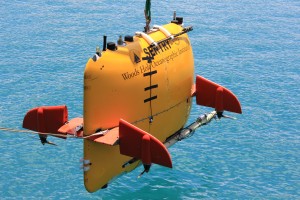2 December 2015
Hydrothermal Hunt: How to recover an Autonomous Underwater Vehicle
Posted by lhwang
By Thom Hoffman
The Sentry Autonomous Underwater Vehicle (AUV) can reach depths of 6,000 m (or about 3.73 miles) below sea level. It is one the best tools for detailed mapping of the water column and deep ocean floor. But even if your instrument has survived the crushing hydrostatic pressures at the bottom of the ocean, you will find another kind of pressure waiting back up on deck. Recovering unique and precious scientific equipment out of the swelling ocean and putting it back onto a moving ship is an intimidating prospect. Here AUV Program manager, Carl Kaiser, gives us his key tips for ensuring a smooth AUV recovery and how to cope when things start to go wrong.
—Thom Hoffman is a science communicator, multimedia journalist and film-maker based in the UK.











 GeoSpace is a blog on Earth and space science, managed by AGU’s Public Information staff. The blog features posts by AGU writers and guest contributors on all sorts of relevant science topics, but with a focus on new research and geo and space sciences-related stories that are currently in the news.
GeoSpace is a blog on Earth and space science, managed by AGU’s Public Information staff. The blog features posts by AGU writers and guest contributors on all sorts of relevant science topics, but with a focus on new research and geo and space sciences-related stories that are currently in the news.